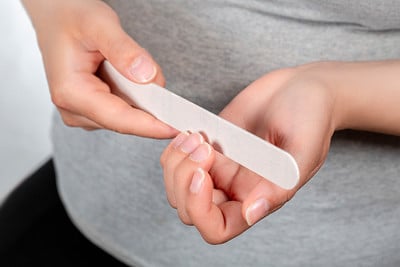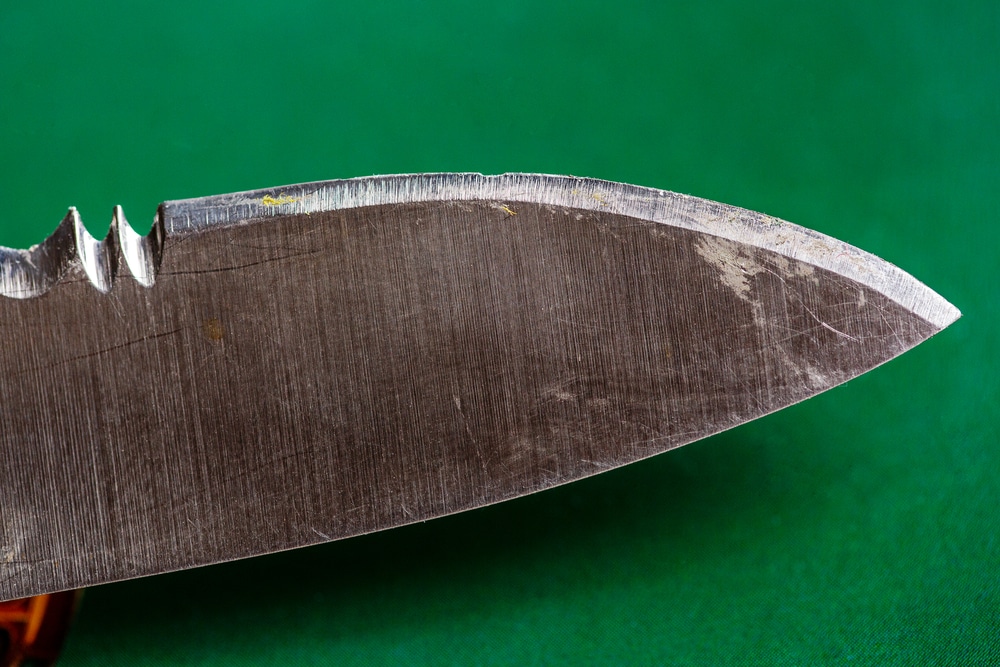If you have ever had to deal with the headache of a blunt knife before, you might have asked yourself how to sharpen a knife without a knife sharpener. For those of us who don’t spend too much time in the kitchen, a knife sharpener can seem like a luxury item – something that is reserved just for would-be chefs and creative cooks. However, anyone will struggle to cut and chop with a dull knife.
You don’t need to be a master in the kitchen to understand the benefits of keeping a knife sharp. However, if you don’t have the cash available to buy yourself a sharpening stone or electric knife sharpener yet, this doesn’t mean you should simply throw knives with a blunt edge away.
But first things first, can you sharpen knives without a knife sharpener? The answer is yes. There are various ways to sharpen knives without an official sharpening rod or surface. And here are some of the easiest options to try.
What Everyday Objects Can You Use to Sharpen a Knife at Home?
You’d be surprised how many household items you can use to sharpen knives. After all, what you need to improve your knife blade is a rough surface capable of refining the edge of your knife.
1. Ceramic Mug, Plate or Bowl
One of the most common solutions is to use the flat surface of your coffee mug.
While most of the area on your coffee mug will be polished and lacquered, you’ll see a slightly ceramic porcelain surface on the bottom when you turn that mug upside down. Although this may not be true of all mugs, most will have a rough surface.
The ceramic surface on the bottom of your coffee mug can be an ideal coarse grit or fine grit sharpening stone, depending on its texture. All you need to do is find an old mug with quite a rough bottom, flip it upside down and place it on a hard surface (like a table or kitchen counter).
Take your knife and place it at a 10-degree angle against the surface of the mug. Using the blade’s full length, stroke the knife across the gritty edge, then lift the knife and repeat the same action on the other side. You can test the knife on a piece of paper to see if it’s sharper.
If you don’t have a mug, similar products will work the same, such as:
- A ceramic plate or bowl
- The bottom of an empty jam jar
- Sandpaper (with a fine grit)
2. Leather Belts
Outside of your ceramic mugs and jars, there are several other items you can use to sharpen the top edge of your knife without a sharpener. For instance, many people use household objects like a leather belt or a leather strop to deal with a dull blade. Leather strops or even a nylon strap can work similarly to a whetstone for removing any burrs on your knife.
3. Another Knife
Why worry about hitting the hardware store for sharpening tools when you can sharpen dull knives using another knife. Using the second knife to sharpen the other is often a great idea if you have two knives. Before you get started, it’s worth noting that sharpening knives in this way isn’t always as easy as using a leather belt or nylon straps.
Don’t use the knife’s blade in this process, but instead focus on the back of the second knife. It’s much harder to damage the back of a knife than the blade. To use this method, hold the knife you want to sharpen in one hand, and the sharp knife in the other. Rotate the knives so that both blades face towards the right and take your second knife, placing it at a 10-degree angle to the first knife. Strike the blade of the first knife, making sure to move the second knife away from you.
4. Nail File
Knife sharpening becomes a lot easier when you realise you can create a sharpened knife with a range of products you’ll easily find around your home. You can even sharpen survival knives on the road with everything from a broken glass bottle to a car window.

One trick for sharpening your knives at home without a sharpener is to use a nail file. Nail files are quite rough, like sandpaper or the rough part on the ceramic plates and mugs we mentioned earlier. Nail files are also common household items, so you’re likely to have one with a decent grit around your house. You’ll need to ensure the nail file is strong enough to withstand your knives, even if they’re not sharp.
Blades can easily slice through sandpaper and nailfiles that are not made with metal, so be careful. If you will be using a metal nail file to sharpen your knife, try to choose a larger one to avoid cutting yourself. Follow these steps:
- Place your nail file on a hard surface, with the rough part facing up. You don’t want to sharpen your knives on your knee or in the air, as this can lead to injuries.
- Place your knives at a ten-degree angle to the surface of the file, like you would with any sharpening process.
- Stroke the blade away from you into the file while using the other hand to hold the file in place. Run the full, smooth surface of the edge of the knife over your nail files.
- Move your stroke to cover the blade’s full length with your nail files, then flip the knife over to get the other side.
- Be careful to hold your nail files steady while you’re using them as a sharpening rod.
- You can check the cutting edge of your newly sharpened knife on a piece of paper or a vegetable to see if you need to continue.
Sharpening a Blade Without a Knife Sharpener
Some of the other options you can use to make knives sharp without an official sharpening tool include:
1. Broken Glass Bottles
Although it is a bit more dangerous than honing a knife with nylon straps, a glass bottle can help to improve your knife edge quickly. Unpolished glass is useful for sharpening knives because it has a slightly coarse, rougher texture. Since it’s dangerous to break a glass bottle yourself, you can use a glass cutter to slice through broken glass cleanly.
Remember not to pick up any broken glass without plenty of protection. You’ll need something strong to cover the broken glass and stop it from slicing your fingers. Use the broken glass edge to swipe down the edge of your blade, making sure you move the glass away from you as you work.
2. A Rock With a Flat Surface
While you might not have access to a honing rod at home, you can probably find a flat rock somewhere around your property. A flat rock or even a tough wooden block can be an excellent alternative to a whetstone or sharpening stones.
To sharpen your knife quickly, you’ll need access to a pretty flat rock that isn’t going to harm your blade. It is also helpful to clean the rock before starting and to use water to lubricate the surface while working on your knife. Make sure you keep the edge facing away from you as you sharpen the steel or metal surface.
3. Car Windows
Similar to ceramic plates and broken glass, a car window can act as a sharpener for your knives when you don’t have other tools available. If you need to sharpen a knife without a knife sharpener, you can open your car window slightly and use the rough edge on the very top of the glass in the same way you’d use a honing rod.
A car window can be an excellent way to sharpen steel when you’re on the road. Simply open the window of your car about halfway and check the top to see if the edges of your windows are slightly rough. Place your knife at a 10-degree angle on the edge if they are. Then, stroke the blade away from you into the window of the car. This will help to smooth the surface of your knife.
The Best Way to Sharpen a Knife at Home
Even if you have the right tools or sharpening surfaces at home, learning how to sharpen a knife correctly can take time and patience. However, once you get the hang of it, knife sharpening can be a quick and easy process you can do with virtually anything, from a broken glass bottle to a nail file.
Of course, the best way to sharpen high-quality knives is to invest in the right sharpening surface. An electric knife sharpener or whetstone will make it much easier to take good care of your blade without having to mess around with different sharpening products you can find at home.
If you need to figure out how to sharpen a knife without a sharpener, the best option will be the easiest tool for you to use. If you only have small nail files to use as a sharpener, for instance, you might find it less hard to sharpen your blade against a piece of coarser grit sandpaper.
Safety Tips
If you’re worried about cutting yourself when sharpening with sandpaper, you can consider using a homemade whetstone such as a piece of slate or a ceramic tile. Whenever you’re sharpening a blade at home without a sharpener, remember these tips:
1. Protect your hands.
Wear strong gloves to protect your hands, whether you’re using sandpaper or a glass bottle. And, make sure you’re not exposing yourself to any unnecessary injuries.
2. Use a ten-degree angle.
Hold the blade at a ten-degree angle when sharpening to help smooth out the edge of the steel and get rid of any burrs.
3. Stroke the knife outwards and away from you.
No matter the sharpening surface, from sandpaper to glass, always move the blade away from you and outwards.
4. Don’t sharpen on your knee.
Always use a flat, stable surface when you’re sharpening a knife. Do not try to sharpen a knife on your lap or knee.
5. Know when to give up.
If you think you might be causing more damage to your blade with your choice of sharpening technique, you might want to consider investing in a professional tool for your dull knife.
Remember, if you’re only sharpening your knives every so often, you may opt to seek a professional to sharpen your knives for you.
Good Luck Sharpening Your Knives
A sharp knife is a must-have investment in any survival situation or cooking experience. The good news is if you don’t have the cash to splash on a professional knife sharpening tool, you can always learn to hone your tool without a sharpener.
Learning how to sharpen a knife without a knife sharpener – using everything from sandpaper to glass – will ensure you can always access a freshly sharpened blade when you need one. Once you’ve sharpened your knife, remember to test the edge of the blade to determine whether it still needs any additional work. You can try cutting through a vegetable or a piece of paper to get a good insight.
Additional Resources
- How to Open a Can Without a Can Opener
- How to Use a Can Opener
- How to Use a Food Flask
- What Pans Can You Use on an Induction Hob
Tom is a former chef turned full-time food blogger. He has always been passionate about food, and loves nothing more than experimenting in the kitchen and sharing his recipes with others. Tom’s blog is one of the most popular food blogs on the internet, and he has won numerous awards for his cooking. When he’s not blogging or cooking, Tom enjoys spending time with his wife and two young children.

